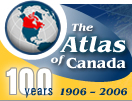
|
 |
 |
 |
 |
References and Links
 |
|
References and Links has information on the map sources, bibliographic references and links to related Web sites.
List of References and Links:
|
|
 |
 |
Map Sources |
|
The Atlas maps are composed of several layers of which there are two broad categories: thematic and base layers. Find below a description of each of the map layers. The layer source is included in the metadata.
Thematic Map Layers
- Late Winter Frequency of Sea Ice (February 26)
- This map layer shows the frequency or probability of encountering sea ice at the end of the winter freeze-up season (February 26). It was created from Canadian Ice Service’s Regional Ice Charts from 1969 to 1998.
- Read the metadata on this layer
- Late Winter Predominant Ice Type (February 26)
- This map layer shows the typical ice types remaining at the end of the winter freeze-up season (February 26). It was created from Canadian Ice Service’s Regional Ice Charts from 1969 to 1998.
- Read the metadata on this layer
Base Map Layers
- Atlas of Canada Framework Layers
- Base map components are features that provide a geographic
context for the thematic data shown on Atlas of Canada maps.
These features include rivers, lakes, administrative boundaries,
populated places, roads and rail lines. All of the Atlas of
Canada base map components are available for immediate free
download in five scales and in a number of data exchange formats.
The 1:7 500 000 and the 1:1 000 000 scale data are the primary base
frameworks used for all Atlas of Canada 6th Edition online
maps. You can download Atlas of Canada data from this Web
page on GeoGratis.
|
|
 |
References |
|
Canada. Environment Canada. 2001. Sea Ice Climatic Atlas: East Coast of Canada, 1971-2000. Ottawa: Canadian Government Publishing.
Canada. Environment Canada. 2002. Sea Ice Climatic Atlas: Northern Canadian Waters, 1971-2000. Ottawa: Canadian Government Publishing.
|
|
|
|
